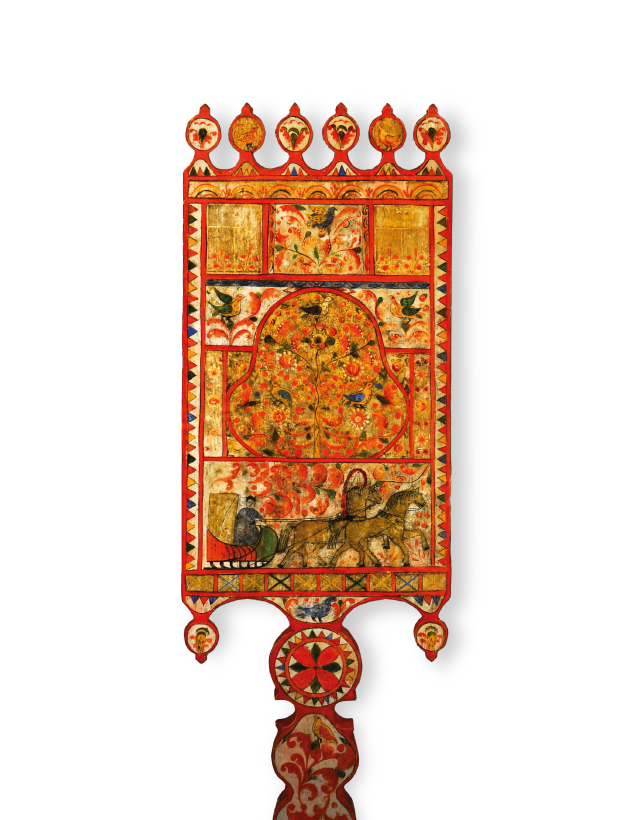Exhibitions
Fairy tales in household objects of peasant
Kolomenskoe
MARCH 21, 2023 — MARCH 31, 2024
Kolomenskoe Peasant’s Farmstead: bldg. 72, 39 Andropov Avenue
On March 21, the exhibition "Fairy Tales in the objects of peasant life" will open at the Kolomenskoe Peasant’s Farmstead. The exhibition presents items from the Kolomenskoe Museum-Reserve collection.
The daily life of a peasant was laced with a fabulous atmosphere: the Kolomenskoe Peasant’s Farmstead visitors will be able to find out who a domovoy is, how a house spirit differs from a yard one, why mermaids were considered the patrons of the dwelling, how to recognize a Leshy (a forest spirit) and where to look for a Vodyanoi (a water spirit).
‘Often in folk tales that lead us into the world of the unknown, there are words which meaning we no longer understand. Children and even many adults will not be able to explain what an oven fork is, what a spindle looks like, or what a mortar was used for… At the exhibition, you will see all these objects, find out what they were used for and in which fairy tales they were mentioned.’
Olga Vorobyeva, the exhibition curator
The exhibition presents a carved plaque with the image of a mermaid, which once protected the residents of a house in the Nizhny Novgorod Governorate. Next to it you’ll see a yarn comb, because in folklore these river deities were often depicted combing their loose hair with a comb. The oven fork and towel will remind you of the fairy tale “Animal Milk”, in which the Zmey Gorynych turns into n oven fork, and Tsarevich Ivan turns the towel into a bridge across the river. The spinning wheel and the spindle will remind you of the plot of the fairy tale “The Feather of Finist, the brave falcon”, where the beautiful maiden goes to a far-away kingdom to search of her fiance. And the fairy tale “Vasilisa the Beautiful” will introduce you a mortar as Baba Yaga’s transport.
Spinning wheel. Russia, Arkhangelsk Governorate. (Severnaya Dvina River, Puchuga). Early XX century. Wood, tempera; carving, painting, gilding.
Mortar for grinding salt. Russia (Angara region, Bratsky Stockaded Fort, Padun village). Late XIX — early XX century. Wood, metal; handicraft work, chiseling.
Façade board with the image of a mermaid (fragment). Russia, Nizhny Novgorod Governorate. Second half of XIX century. Wood; carpentry, carving.
Spinning wheel. Russia, Arkhangelsk Governorate. (Severnaya Dvina River, Puchuga). Early XX century. Wood, tempera; carving, painting, gilding.
Mortar for grinding salt. Russia (Angara region, Bratsky Stockaded Fort, Padun village). Late XIX — early XX century. Wood, metal; handicraft work, chiseling.
Façade board with the image of a mermaid (fragment). Russia, Nizhny Novgorod Governorate. Second half of XIX century. Wood; carpentry, carving.
Spinning wheel. Russia, Arkhangelsk Governorate. (Severnaya Dvina River, Puchuga). Early XX century. Wood, tempera; carving, painting, gilding.
Mortar for grinding salt. Russia (Angara region, Bratsky Stockaded Fort, Padun village). Late XIX — early XX century. Wood, metal; handicraft work, chiseling.
Façade board with the image of a mermaid (fragment). Russia, Nizhny Novgorod Governorate. Second half of XIX century. Wood; carpentry, carving.
The Kolomenskoe Peasant’s Farmstead is part of the ethnographic complex of the Kolomenskoe Museum-Reserve. The house was recreated according to preserved archival documents and drawings of a real dwelling. Mainly the peasants of Kolomenskoe were engaged in farming and even brought out a special kind of cabbage called “Kolomenka”. Next to the house you can see a vegetable garden. Chickens, a cow and a horse live in the farmstead. Kolomenskoe peasants were considered well-to-do, so in the interior exhibition you can see objects that were fashionable for the end of the XIX century: a gramophone, a watch, a Singer sewing machine. In the basement, you can see the tools the peasants used to work in the farm, learn how they stored the harvest and visit the village shop.